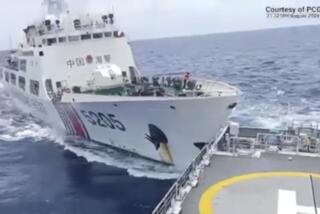U.S. Flies a Spy Plane Along China Coast
- Share via
WASHINGTON — The Bush administration sent a reconnaissance plane along the coast of China on Monday for the first time since a Navy aircraft collided with a Chinese fighter jet April 1, officials said. No Chinese planes challenged the flight.
An Air Force RC-135 stationed in Japan flew the daylight mission, cruising in international airspace off the northeastern coast of China. President Bush and other top officials had insisted since the earlier plane made an emergency landing in China that the surveillance activity would resume.
Officials said the latest flight, like earlier ones, was not accompanied by U.S. warplanes. Although there were calls from Capitol Hill to send fighter escorts with the reconnaissance plane, the administration decided that such a procedure would be provocative.
Resumption of the surveillance activity is certain to further strain Sino-American relations. But the Pentagon tried to keep the flight as low-key as possible.
The RC-135, a four-engine jet, flies higher and faster--and can operate farther from its target--than the Navy turboprop EP-3 that was involved in the collision. By using a plane that can collect information from a greater distance, the U.S. military avoided the sort of direct challenge that would have resulted from flying closer to Chinese territory. Also, Beijing’s scrambling of military planes to meet perceived threats has been more intense in the south.
Neither of the unarmed electronic spy planes would be a match for a fighter jet. But U.S. officials say they are confident that China would not risk a major confrontation by trying to shoot down an American plane.
Before the April 1 incident off China’s southern coast, Chinese warplanes frequently flew dangerously close to U.S. reconnaissance aircraft, but they never attempted to shoot one down. Defense Secretary Donald H. Rumsfeld has said that the collision was clearly an accident.
Nongovernmental military experts say that before the collision, the Pentagon was flying EP-3 aircraft near China as often as twice a week. There was no indication Monday whether the administration intends to return to that level of frequency.
Meanwhile, U.S. and Chinese diplomats continued to negotiate about the fate of the damaged EP-3, which remains on a military airstrip on China’s Hainan island.
Rumsfeld said Sunday that U.S. technicians who inspected the aircraft last week believe that it can be repaired and flown home. The Defense secretary said he thinks that China will agree to that, although the Beijing government has not yet given a definitive answer.
“We’ll know later this week,” Rumsfeld said on NBC’s “Meet the Press.”
The RC-135 operates with a crew of up to 27, including three pilots, two navigators, three electronic warfare officers, 14 intelligence operators and maintenance technicians. The EP-3 involved in the collision carried a crew of 24. China held the crew members for 11 days before they were allowed to return to the United States.
The pilot of the Chinese jet was killed.
U.S. officials say China probably obtained valuable intelligence information from its examination of the EP-3’s sophisticated electronic equipment, although the crew apparently managed to destroy the most sensitive information before making its emergency landing.
More to Read
Sign up for Essential California
The most important California stories and recommendations in your inbox every morning.
You may occasionally receive promotional content from the Los Angeles Times.













